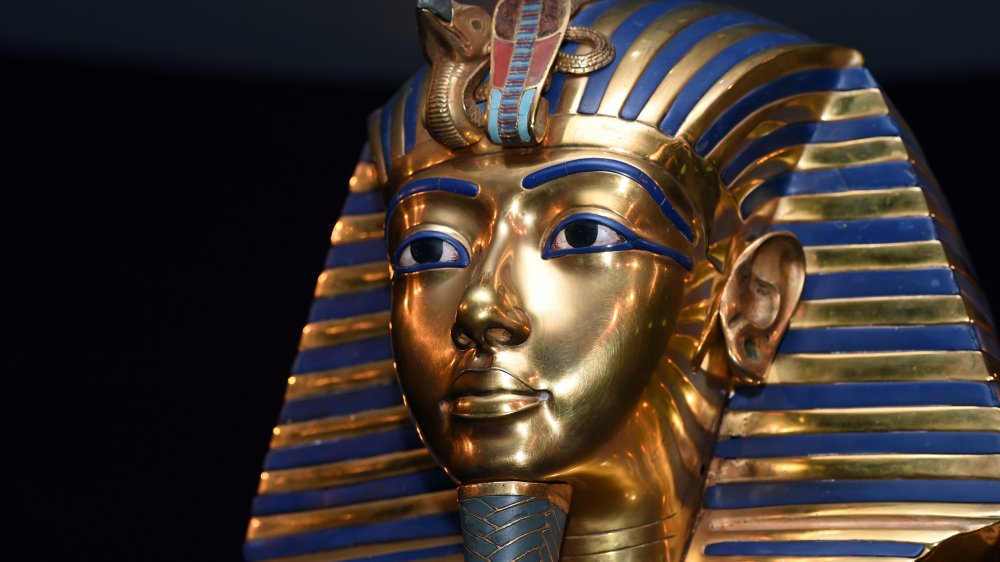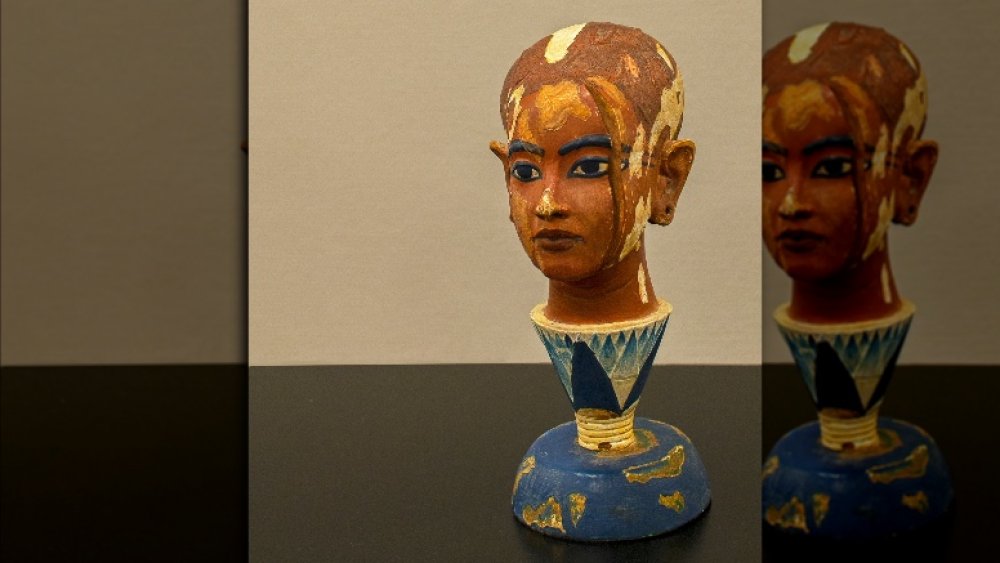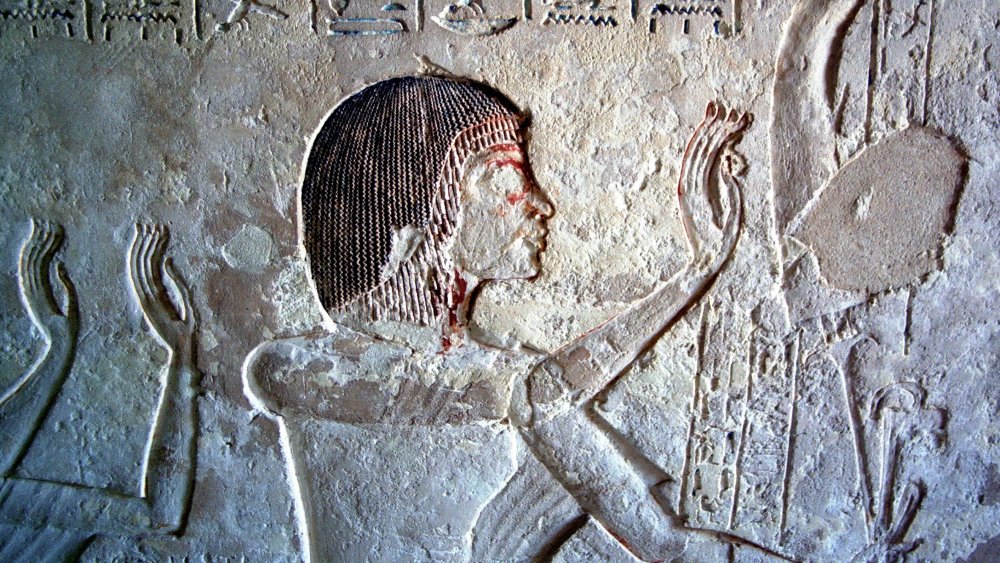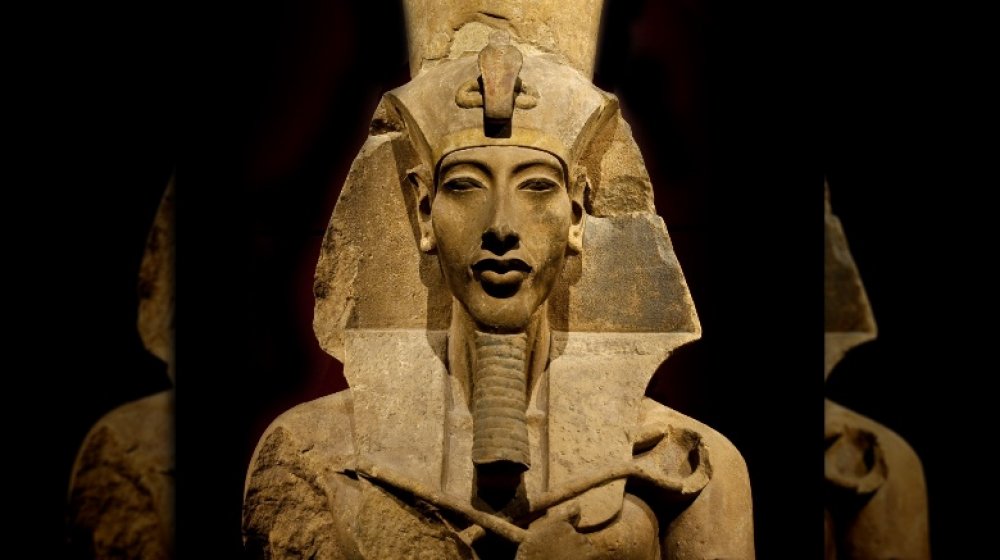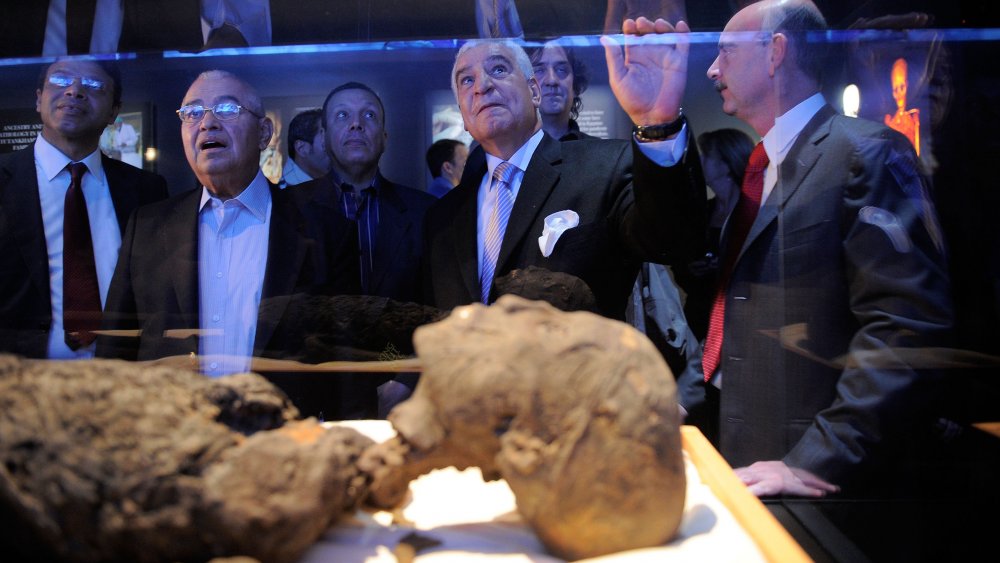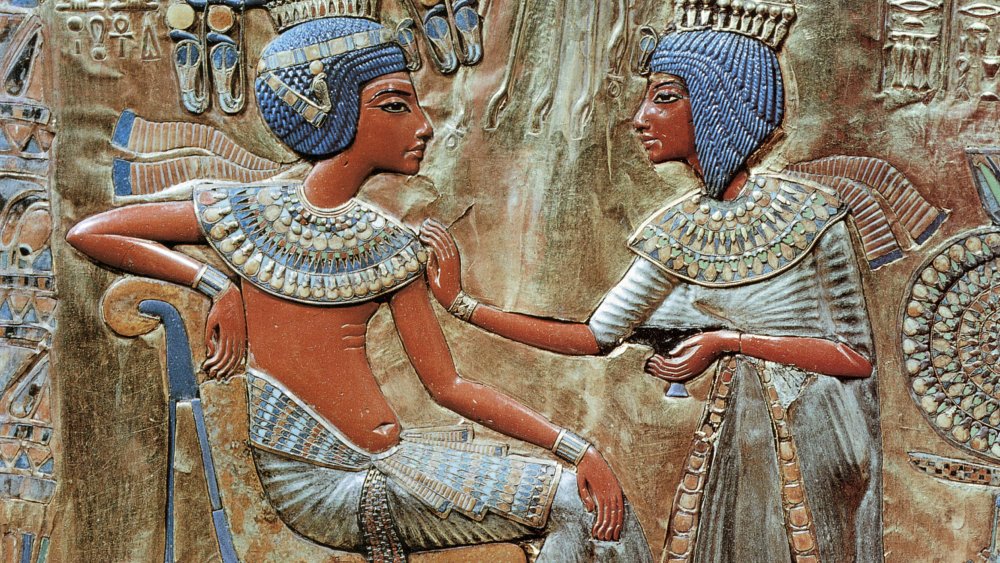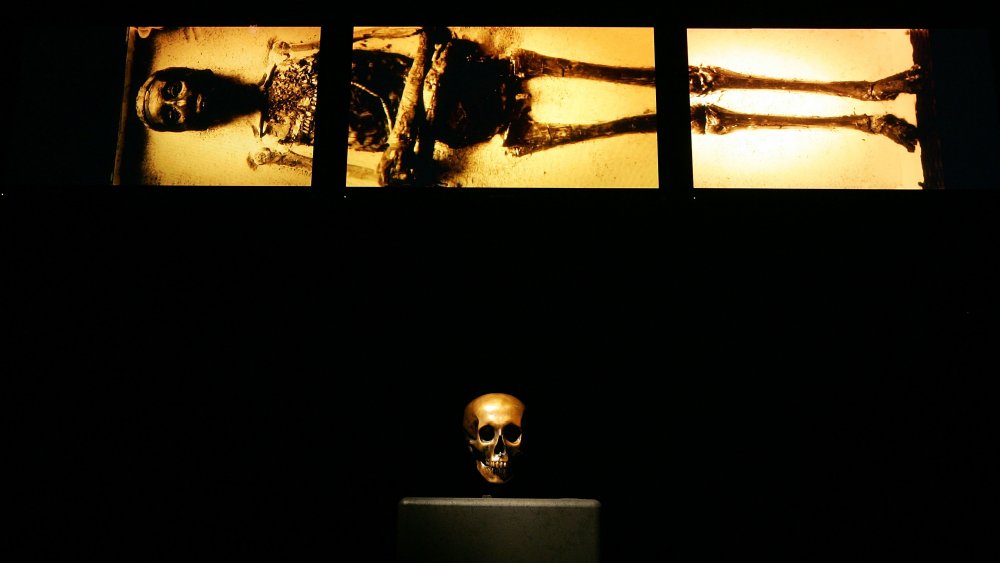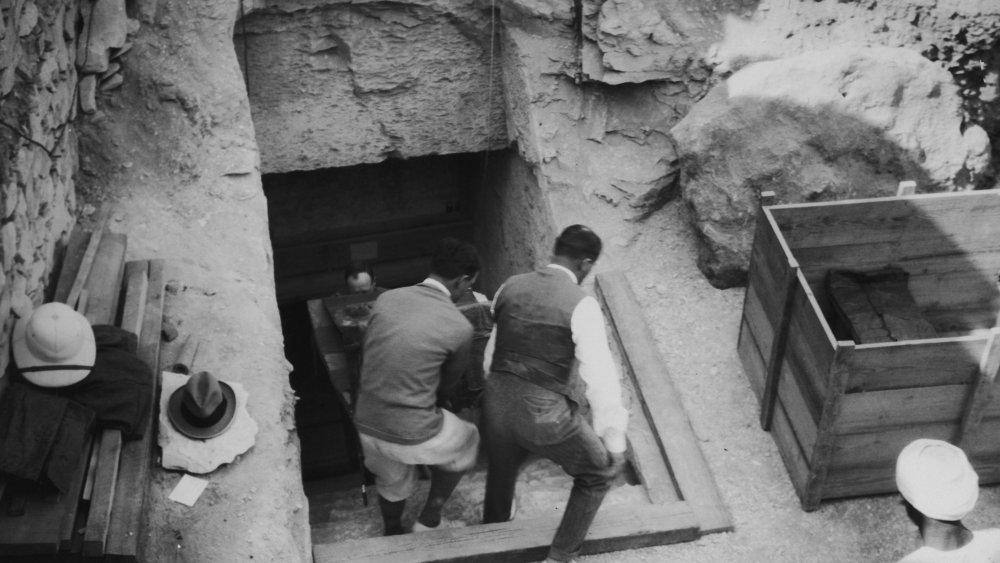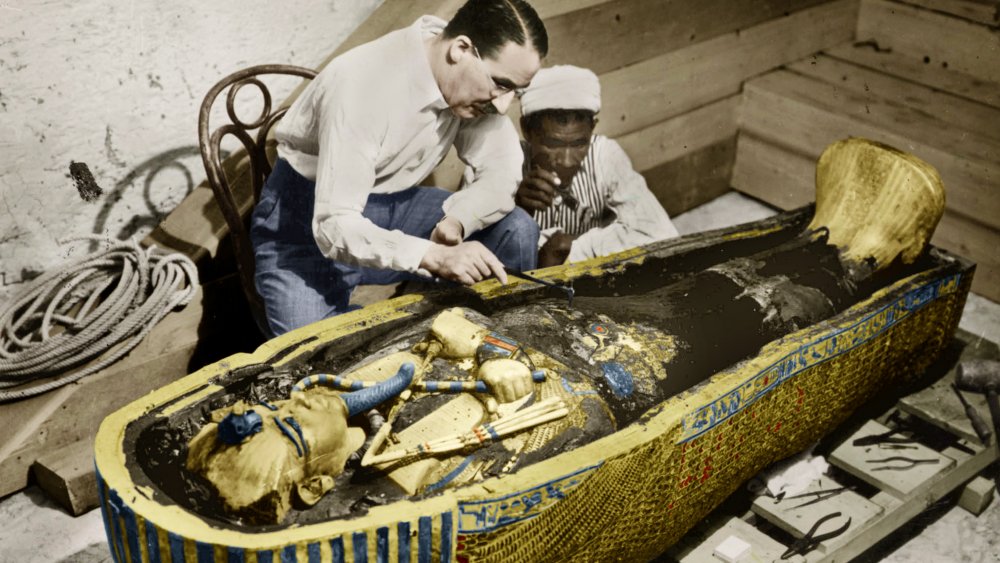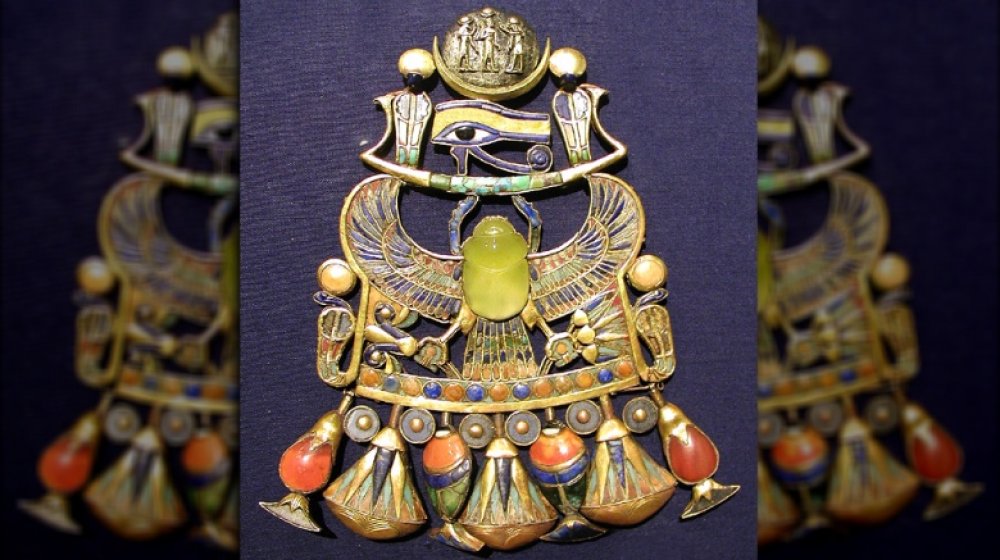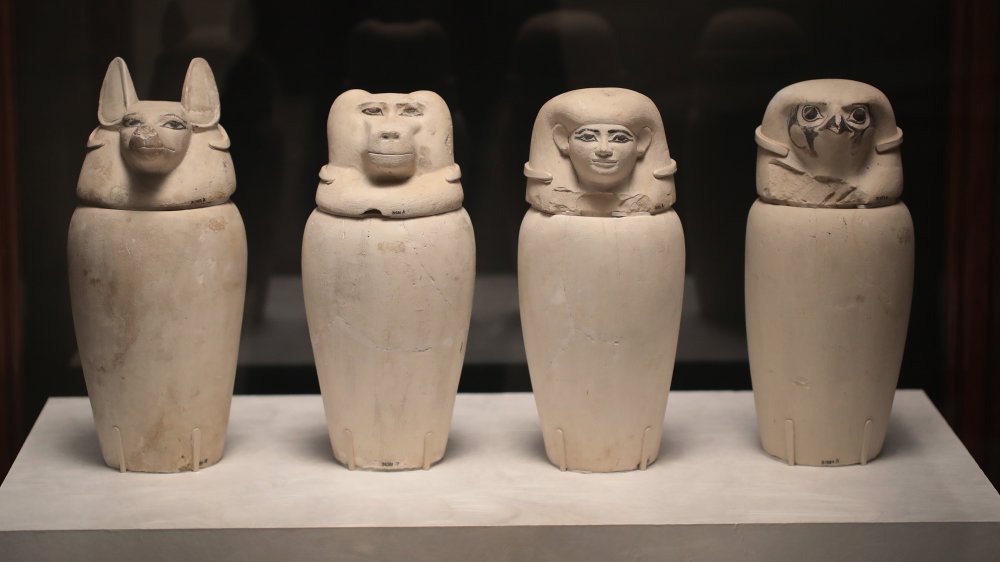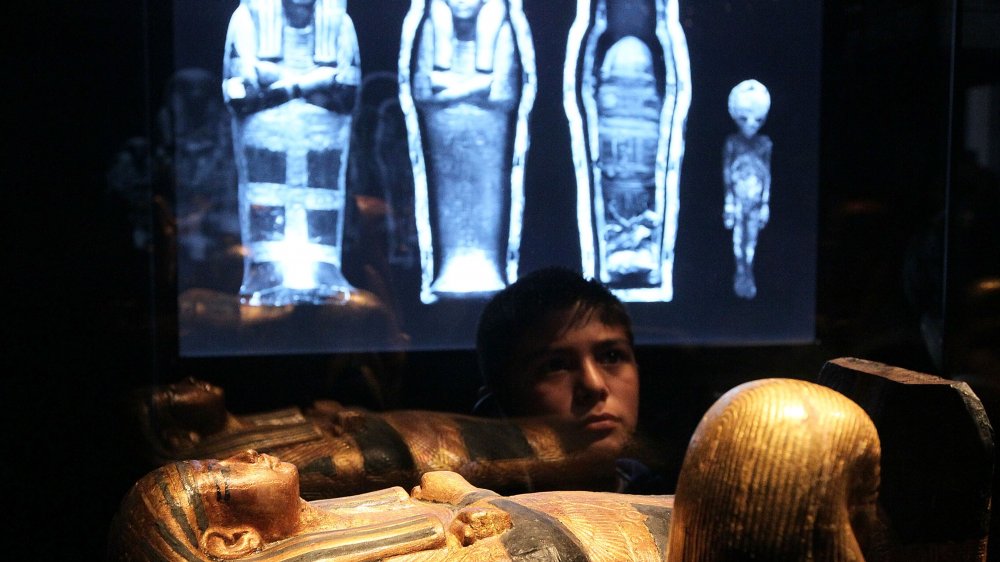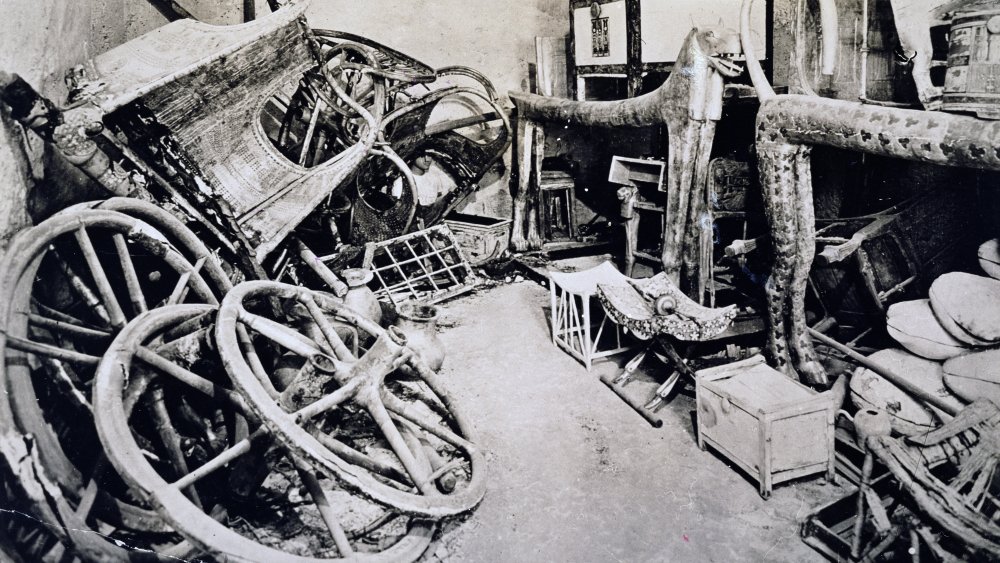The Untold Truth Of King Tut
Even if you have only a passing interest in Ancient Egypt, you still know who Tutankhamun was. You can probably identify his fancy gold mask without giving it much thought, and you probably also know that he was a boy king and his tomb was cursed. That's just basic human knowledge, right alongside things like "the ocean is salty" and "creamed tuna on toast is disgusting."
But even if you have more than a passing interest in Ancient Egypt, you may not have heard some of the lesser known facts about King Tut. For example, his tomb wasn't actually cursed (in fact on average, the people closely involved in its opening lived to the ripe old age of 73) and the only reason anyone remembers him at all is because his stuff managed to languish underground for 3,000 years without anyone looting it. But there's more than that — King Tut had a short and sordid life, a mysterious death, and some weird Targaryen stuff going on with his family tree. Here are some of the things you might not have known about the opulent boy king.
His name wasn't Tutankhamun
Okay it was Tutankhamun, eventually, but that's not the name that the boy king was given by his parents. According to Ancient Egypt Online, his given name was Tutankhaten, which means "Living image of the Aten." He was given that name by his father, the "heretic king" Akhenaten, who earned his nickname because he told his subjects they had to stop worshiping multiple gods and only worship this one god that he liked. Tut got his original name from that god, a sun deity called "Aten." Incidentally, Akhenaten's religious decree was exactly as popular as you might imagine it would be.
In fact Akhenaten's state religion was so unpopular that when he died, leaving his 9-year-old son in charge of Egypt, the boy king's advisors thought better of introducing him as the living image of the monotheistic sun god and changed his name to Tutankhamun, which means "Living image of the Amun." Amun was the more traditional sun deity who was content to share the fame with other gods, and the name change was basically a promise to the people that the old days of monotheism were going to be replaced with the happier and more familiar days of polytheism.
He probably didn't make a whole lot of independent decisions, at least not at first
When you hand the reins of power to a 9-year-old, you're kind of setting yourself up for a lot of grief. Let's face it, a 9-year-old with a crown is going to do a lot of stupid things like make broccoli illegal and decree that school shall take place only in the Minecraft Universe and use rock paper scissors to decide whether or not to chop someone's head off. So juvenile rulers need to be supported by someone who can run the country for a little while, or at the very least rein in some of the king's more childish impulses.
According to National Geographic, King Tut had one such advisor — his name was Ay, which let's face it is not so much a name as that thing the Fonz used to say — but he probably wasn't motivated by anything so pedestrian as the good of the nation or helping Tutankhamun be a wise and competent king or anything. Ay appears to have mostly been interested in using Tut as a puppet so he could wield the real power behind the scenes. In fact, Ay appears to have hung around for the duration of Tut's reign, and although records are spotty it seems that he actually ended up becoming pharaoh after Tut's death and may have even gone on to marry the unfortunate king's widow.
There were all kinds of Targaryen-y things happening in that family tree
Most cultures have taboos against marrying close relatives, and for good reason. In the old days, people really didn't understand genetics and genetic disorders, but they probably couldn't help but notice there were a lot of kids with three eyes and webbed armpits in Billy Jo Bob's cousin's mother's sister's family. But a few categories of people never really did get clued into all of that, and somehow concluded that the family tree could be kept "pure" if you only ever married people who were already in your family tree. The pharaohs of Egypt appear to have been one such category.
So poor Tut was kind of doomed from the start. We're pretty sure based on the historical record that he was the son of Akhenaten, which means a lot of people logically just assumed he was also the son of Akhenaten's famous wife Nefertiti. That assumption got turned on its head, though, when genetic evidence revealed that his mother was actually Akhenaten's full sister, a mummy dubbed "The Younger Lady." Okay so ew, but Daenerys' parents were brother and sister too and she turned out okay (except for the whole mad queen thing). Well, Daenerys got lucky — according to Psychology Today, the odds of a union between first-degree relatives (individuals who share 50 percent of their genes) resulting in a serious birth defect or a mental deficiency are about 50/50.
He was kind of messed up
So you're probably wondering which side of that 50/50 crapshoot Tutankhamun ended up on, and if you guessed "serious birth defect," you were right. King Tut was a sickly kid and that didn't improve much as he got older. According to National Geographic, Tut also had a messed-up foot, which appears to have been caused by necrosis (the death of living tissue) and never really healed right. His foot condition was so bad that he needed a cane to walk.
That wasn't his only health challenge, though. Although it is kind of difficult to identify specific genetic disorders on a 3,000 year-old corpse, Smithsonian says it's likely that the king suffered from less-visible genetic afflictions that contributed to his weakened state. Analysis of the king's mummified tissues have also revealed that he had two different strains of malaria tropica, which is the deadliest version of the malaria parasite. The malaria likely weakened the young king's already not super-robust immune system, which would have made recovery from his foot necrosis and any other injuries he may have received especially difficult.
Tut's weird inbred bloodline mercifully ended with him
One thing about inbreeding, at some point it ends up being self-limiting. A person born to first degree relatives may luck out and not carry any noticeable genetic defects, but if that person then tries to father a child with another first-degree relative, well, there's going to be a kind of snowball effect. That didn't stop the Tuts, though, who never once paused and said to themselves, "Hmm, something is just not right about the way that our son and heir is put together." Or maybe they did, but figured he'd gotten into some bad oysters or spent too much time in the sun. Whatever it was, they managed to successfully ignore the evidence so they could cling to their gross marriage traditions.
In order to keep the royal bloodlines even purer, King Tut married his half-sister Ankhesenamun, which ended up being a genetic dead end. According to National Geographic, Tut died without any heirs and it was probably a good thing, too, because the children he would have produced with his half-sister likely would have had a host of abnormalities, from learning disabilities (if they were lucky) to things like hemophilia, congenital heart disease, or cystic fibrosis.
King Tut died boringly
Over the years there have been a lot of theories about how King Tut died. One of the favorites: He was murdered. And despite there not being really a ton of evidence to support that one, it persisted because, well, it's fun. Everyone loves a murder mystery.
So what exactly drove archaeological sleuths to speculate that the king was a victim of foul play? He appears to have had a head injury, so that led some people to believe that he'd been clubbed from behind by a rival who was like, "Ew, you married your sister" or maybe by his wife, who was like "Ew, you're my brother." But alas, an X-ray he received several thousands of years later put that theory to rest — the injury didn't even occur until after he was already dead. So, poison? Nope, there's no evidence for that, either.
What did kill the boy king, then? Well, unless the murderer broke Tut's leg and then just hoped it would get infected and kill him, which does seem rather diabolical actually, then recent analysis of the corpse seems to have concluded that King Tut died of natural causes. Yes, according to National Geographic Tut died from a broken leg, which seems crazy in our times when literally no one dies from a broken leg. When you're inbred, though, that does rather make your body not super good at healing itself. So broken leg equals infection equals painful death. Case closed.
King Tut's tomb was way too small for a pharaoh
If anyone is going to live to a ripe old age, it's going to be a king. You know, as long as security is pretty tight, he's got a poison checker, and his sister/wife doesn't try to kill him in his sleep.
Anyway, most pharaohs intended to live a long time because their entry into the afterworld required a massive tomb that took decades to build. Unfortunately for Tut, he reigned for just 10 years and died at the age of 19, so there really wasn't really enough time to construct a two-bedroom condo on the Nile, let alone a ginormous tomb out in the desert.
So Tut was laid to rest in a small tomb. According to Scientific American, his tomb had only four rooms, which is kind of too small for a middle class American couple, and practically microscopic for a pharaoh. It's not really clear if the tomb was just hastily built or if it was part of a larger tomb that was repurposed after his sudden death, but only one of the four rooms was painted with the standard-issue hieroglyphics and drawings of the king hunting ostriches and doing other kingly things, which seems to suggest that it was put together in haste. Sucks for the boy king and his afterlife, but the diminutive size of Tut's tomb is probably one of the reasons why it remained undiscovered for so many thousands of years.
The embalmers kind of botched the job
The nice thing about being an embalmer is that your customers can't leave you a bad Yelp review if they aren't happy with your services. That's an especially good thing for King Tut's embalmers, who weren't, shall we say, especially concerned about the quality of their work.
According to Ancient Origins, King Tut's embalmers poured an excessive amount of black resin all over the boy king's corpse. And by excessive, we mean La Brea Tar Pits excessive. They didn't just saturate the body in the stuff, either, they also poured it all over the coffin, which made the coffin so difficult to open that the mummy was damaged during the effort. Not that it mattered a lot, though, because there was so much embalming fluid — an estimated five gallons of it — on the corpse that it caused a chemical reaction that basically destroyed all of King Tut's chances at walking into the afterlife in a pristine body.
There's also evidence that Tut was suspended upside down for a while, which does seem like a strange thing to do to a king, even a dead one. And the poor kid's body was described as a "charred wreck" 3,000+ years after his death, with "charred" being an accurate word — Chris Naunton, Director of the Egypt Exploration Society, concluded that the combination of oils, linen, and oxygen may have actually caused the boy king's body to combust. Some afterlife.
He had a breastplate decorated with space glass
The Ancient Egyptians believed their Pharaohs were gods. Now, King Tut couldn't swing a magical hammer (inbreeding) and he didn't have lightning powers and he couldn't smite his enemies with a look, but he did have a really cool breastplate made from heavenly materials. According to Forbes, one of the many treasures found in Tut's tomb was a breastplate decorated with a really odd-looking yellow-green stone carved into the shape of a scarab beetle. At first the stone was misidentified as chalcedony, which is a rather uninspiring and not super-valuable material. Then, in 1932, a British geographer discovered pieces of yellow-green glass in the Great Sand Sea along the Egyptian and Libyan border that looked identical to the stone on King Tut's breastplate. But it wasn't until 1998 that the material was finally identified as Libyan Desert Silica Glass, one of the rarest substances on Earth.
The weird thing about this stuff is that glass can only form naturally when molten rock cools really quickly. And molten rock typically comes from volcanoes ... except there aren't any volcanoes out there in the Great Sand Sea. So the prevailing theory about the origins of Desert Silica Glass is that it was formed when a meteorite hit the ground with such force and heat that it melted the sand, forming this very unusual glass. King Tut's breastplate is the only known example of an Egyptian craftsperson working with this particular material.
King Tut was heartless
Not a whole lot is known about King Tut's reign. He didn't really make any of the Egyptian history books or tablets or papyrus or whatever the scribes were using to record the deeds of their pharaohs back then. Generally speaking, though, kings do tend to be sort of heartless. They have to be, because it takes a certain amount of heartlessness to do things like behead your enemies and make a bunch of slaves build a massive tomb for you. Not that King Tut ever did anything like that (that we know of) but still, heartlessness is kind of a royal thing.
According to Ancient Origins, though, King Tut's mummy was literally heartless. Now, if you know anything about mummification (and who doesn't, right?) then you know that the deceased's organs were always removed first. You might also know that the heart was pretty important to the Egyptians — they believed it was the seat of wisdom, so they took care to preserve the hearts of important people. Typically, the heart would be returned to the chest cavity prior to burial, so it's pretty strange that no one knows where Tutankhamun's heart ended up.
There are a few theories. Maybe the embalmers lost it. Maybe they lost it deliberately, to keep the boy king out of the afterword. Or maybe the missing heart was an attempt to equate Tut with the god Osiris, who had his heart ripped out and buried in multiple locations.
King Tut wasn't buried alone
King Tut wasn't the only human found in the tomb designated KV62 — there were also the mummified remains of two stillborn girls. The fetuses were somewhere between 27 and 34 weeks gestation, but for decades it wasn't clear why they were there. The Ancient Egyptians were kind of known for putting weird stuff in tombs, so although there was speculation that these might have been the unborn daughters of the boy king, for decades it was impossible to say for sure.
Until recently, the Egyptian government was reluctant to allow DNA testing on any of its mummies, but in 2010 researchers finally obtained permission to look at the genetic profiles of King Tut and some other mummies that archaeologists suspected might be a part of Tut's weird family. Included in that group were the two mummified fetuses. According to National Geographic, preliminary results suggested that the two fetuses were the stillborn children of King Tut and his sister/wife Ankhesenamun, who may not have been able to carry a child to term given her husband's unfortunate ancestry and their equally unfortunate genetic relationship.
It took more than 10 years to catalog all of King Tut's stuff
There might have been only four rooms in King Tut's tomb, but the dude kind of belongs on an episode of Hoarders because crammed into that small space were more than 5,000 artifacts. There was so much stuff in the tomb, in fact, that it took more than 10 years to catalog it all. Amongst the artifacts: Jewelry, statues, thrones, furniture, weapons, beer and wine, clothing — Tut had a lot of stuff and it all had to come along with him to the afterlife, so one wonders why he didn't have a couple of mummified movers and a Ryder chariot in one of those rooms to give him a hand with all of it.
According to Smithsonian, the complete collection of artifacts from King Tut's tomb will eventually be on display at the Grand Egyptian Museum, which as of 2020 is still under construction less than two miles from the pyramids of Egypt. So if you want the complete King Tut experience, you'll have to plan a long journey (unless you're lucky enough to already live in the area). Take heart, though. Your journey will be nothing compared to the one Tut had to undertake to cross 3,300 years of undisturbed time only to end up under a piece of glass with a bunch of people waving phone cameras at him. It's good to be the king.
